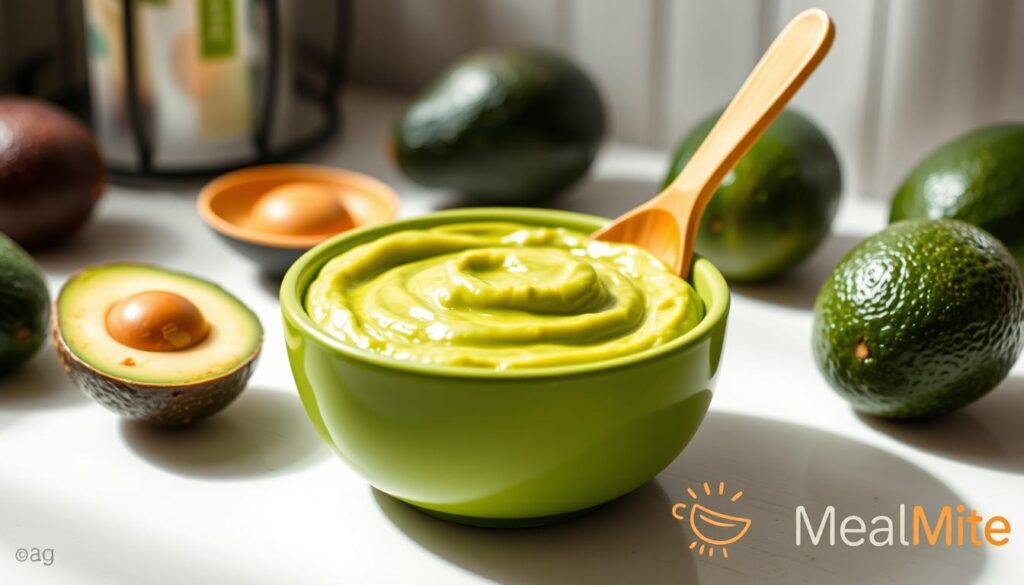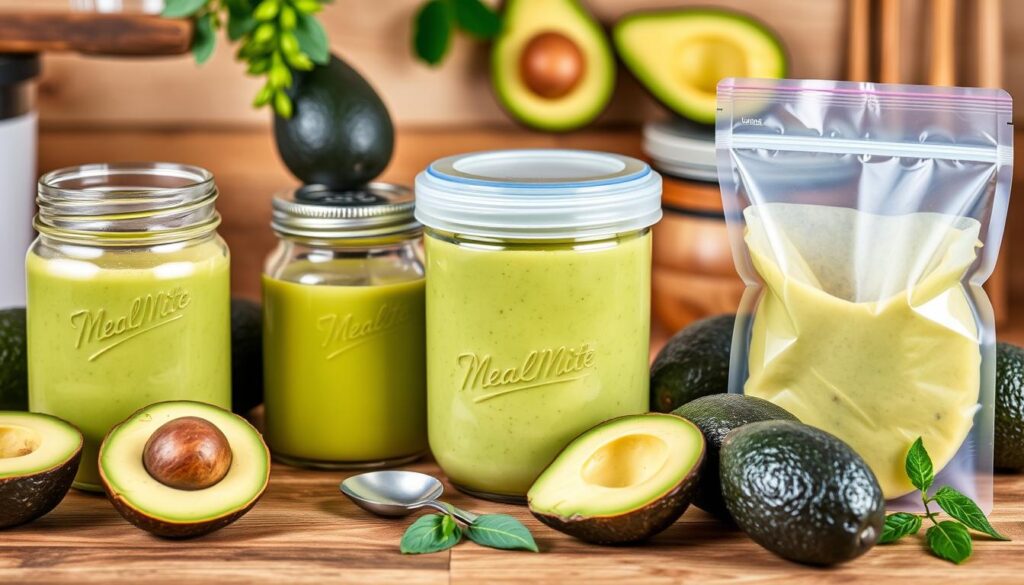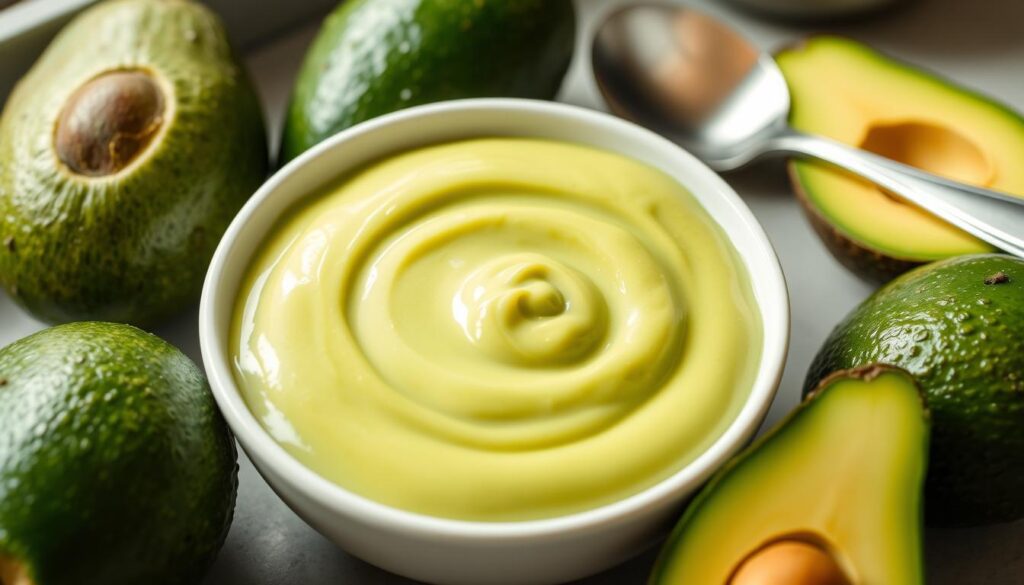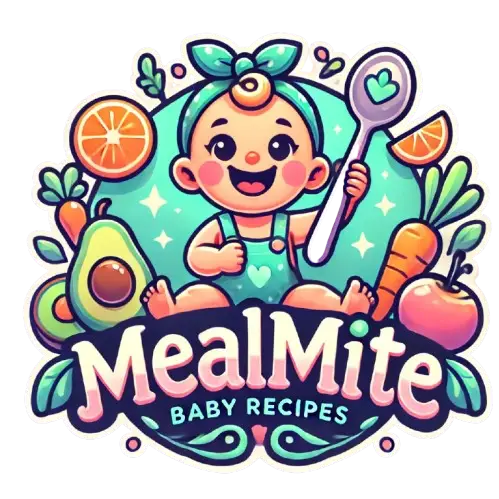Table of Contents
Avocado Puree Recipe: A baby’s brain grows a lot in the first year. Avocados are a top pick for babies because they’re full of good stuff. They’re packed with healthy fats, folate, and potassium, which are key for growing strong.
Avocados are creamy and taste mild, making them perfect for babies. They’re a great way to add these important nutrients to your baby’s diet.

Key Takeaways
- Avocado puree is a nutrient-rich food that provides healthy fats for brain development and growth.
- Avocado baby food is easy to make and can be prepared in less than 5 minutes.
- Avocado puree for baby can be stored in the fridge for 3-4 days or in the freezer for up to 3 months.
- Avocado pairs well with a variety of fruits, veggies, and grains for nutritious baby food recipes, making it a great addition to homemade baby food.
- Avocado puree is a mild-flavored first food for babies and can be mixed with other soft fruits, veggies, and proteins for different textures and tastes.
- Using 100% organic ingredients is recommended for making baby food recipes, including avocado puree for baby.
- Avocado baby food is less sweet than other purees, making it easier for babies to digest.
Benefits of Avocado Puree Recipe
Avocado puree is packed with nutrients, making it a top pick for healthy baby food. It’s a smart choice when introducing solid foods to babies because it’s rich in good stuff and rarely causes allergies. Avocados are full of essential fatty acids, which are key for brain growth and development.
One small avocado (25 grams) is a powerhouse of nutrients. It has 2 grams of fiber, 2 milligrams of vitamin C, and 10 milligrams of magnesium. It also has 20 micrograms of folate and 5 micrograms of vitamin K. These are all important for a baby’s growth.
Avocados also add 2.5 grams of monounsaturated fat and 0.5 grams of polyunsaturated fat per 25-gram serving. These fats are good for a child’s heart and overall health.
- Rich in brain-boosting omega-3s and heart-healthy fats
- Good source of essential nutrients like folate and potassium
- Low risk of allergy, making it a great first food
- Supports healthy digestion and bowel movements
Avocado puree is a nutritious choice for a baby’s diet. It provides important nutrients and supports growth and development. Adding avocado puree to healthy baby food options can give babies a great start in life.
When Can Babies Start Eating Avocado Puree
It’s important to introduce avocado puree to your baby at the right time. Most doctors say to start solid foods around six months. Avocado puree recipes are a great way to give them important nutrients, and baby-led weaning is a good method to introduce avocado puree.
Avocados are full of healthy fats, fiber, vitamins, and minerals. They are also a good source of folic acid, which helps with the development of the nervous system in babies. Start with ripe, mashed avocado, and then move to small avocado slices or pieces.
Here are some tips for introducing avocado puree to your baby:
- Start with a small amount (about 1-2 teaspoons) and gradually increase the serving size as your baby gets accustomed to the new food.
- Coating avocado pieces in breadcrumbs or crushed cereal can improve grip for babies.
- Avocado’s mild flavor makes it easy to pair with other foods for added nutrition.
Always talk to your pediatrician before adding new foods to your baby’s diet, especially if they have allergies or sensitivities. Avocado puree is a great addition to your baby’s diet, and avocado recipes for babies can help provide essential nutrients for their growth and development.
| Age | Food Introduction |
|---|---|
| 4-6 months | Start with ripe, mashed avocado |
| 6-8 months | Progress to small avocado slices or pieces |
| 8-12 months | Introduce avocado as a finger food, coated in breadcrumbs or crushed cereal |
Selecting the Perfect Avocado for Baby Food
Choosing the right avocado is key for nutritious baby food. A ripe avocado feels slightly soft and has a soft spot when pressed. This makes it easy to mash into a tasty baby food.
To pick the perfect avocado, look at a few things.
Ripeness Indicators
A ripe avocado is heavy and soft when pressed. It’s also a bit darker than unripe ones. For the best taste and texture, pick an avocado that’s ripe but not too ripe.
Organic vs. Conventional Avocados
Deciding between organic and conventional avocados is a common question. Organic avocados might have less pesticide. But, washing conventional avocados well can also make them safe and healthy.
Here are some tips for shopping and storing avocados:
- Choose avocados that are heavy for their size
- Store avocados at room temperature until ripe
- Refrigerate ripe avocados to slow down the ripening process
By using these tips, you can find the best avocado for your baby’s food. Enjoy the yummy avocado mash for your little one.
| Avocado Type | Ripeness Indicator | Storage Tip |
|---|---|---|
| Organic | Slightly soft to the touch | Refrigerate to slow down ripening |
| Conventional | Slightly darker color | Store at room temperature until ripe |
Required Tools and Equipment
To make avocado puree for a baby, you’ll need some basic tools. A spoon, glass bowl, fork, and sharp knife are essentials. You can also use a blender or food processor to make the puree. Just make sure to wash it thoroughly before use.
Investing in good knives and a vegetable peeler can make preparation easier. When it comes to freezing and storing the puree, you’ll need some freezer trays. It’s recommended to have 4-6 freezer trays on hand.
WeeSprout freezer trays are a great option for frozen purees. You’ll also need some storage containers, such as WeeSprout Baby Food Storage Containers, to keep the puree fresh in the fridge.
- Ninja Professional Countertop Blender for blending the puree
- Stasher bags or zip-lock baggies for storing frozen purees
- Mini Collapsible Funnel for filling reusable pouches
- Spatula for scraping the blender or food processor
By having these tools and equipment on hand, you’ll be well-prepared to make delicious and healthy avocado puree for your baby. Learning how to make avocado puree for baby is a great way to introduce your little one to the world of solid foods.
| Tool/Equipment | Description |
|---|---|
| Spoon | For scooping and serving the puree |
| Glass Bowl | For mixing and preparing the puree |
| Fork | For mashing the avocado |
| Sharp Knife | For cutting and peeling the avocado |
How to Make Avocado Puree for Baby
Making avocado puree for baby is easy and quick. First, cut the avocado lengthwise and remove the pit. Then, scoop the avocado flesh into a small bowl. This step is key for healthy baby food that’s full of nutrients and easy to digest.
Avocado is a great choice for baby puree recipes because of its mild taste and creamy texture. To get the right consistency, mash the avocado with a fork. You can also add breast milk or formula to make it thinner if needed.
Preparation Steps
The steps to make avocado puree are simple. Make sure the avocado is ripe and soft. Then, follow the steps above to prepare the puree. Remember, avocado puree is best eaten fresh, but you can store it in the fridge for later.
Achieving the Right Consistency
Getting the right consistency is important for avocado puree. It should be smooth and creamy, without lumps. To get this, mash the avocado well with a fork. You can also use a blender or food processor for a smoother puree.
Adding Breast Milk or Formula
If the puree is too thick, add breast milk or formula to thin it. This lets you adjust the consistency to your baby’s liking. Plus, it adds more nutrients, making it a top choice for healthy baby food.
Storage Methods and Guidelines
Storing avocado puree right is key to keeping its nutrients and safety. You can keep it in the fridge for up to three days or freeze it for up to three months. Always use an airtight container and keep it at 40°F (4°C) or below.
Yes, you can freeze avocado puree. It’s a good way to keep it fresh. Use a tight container or freezer bag and mark the date. Freezing might change the puree’s texture and color a bit.
Refrigeration Tips
To keep it fresh, add a bit of lemon juice to the puree. This stops it from turning brown and keeps it good for up to 24 hours in the fridge.
Freezing Instructions
Freezing works best if you puree the avocado first. Adding lemon juice or ascorbic acid helps keep it fresh. Frozen puree can last up to three months.
Signs of Spoilage
Always check the puree for spoilage before giving it to your baby. If it smells bad, feels slimy, or has mold, throw it away.
Here’s a quick guide to storing avocado puree:
| Storage Method | Storage Time | Notes |
|---|---|---|
| Refrigeration | Up to 3 days | Store in airtight container, add lemon juice for freshness |
| Freezing | Up to 3 months | Puree avocado first, add lemon juice or ascorbic acid for preservation |

Creative Ways to Serve Avocado Puree
Avocado puree can add excitement to your baby’s meals. It’s great for baby-led weaning, where babies learn to feed themselves. This helps them improve their motor skills and hand-eye coordination.
There are many avocado recipes for babies to try. You can mix it with fruits or veggies, add it to oatmeal or yogurt, or use it as a topping. Even making avocado toast or adding it to your baby’s favorite dishes is a good idea.
Here are some creative ways to serve avocado puree to your baby:
- Mix with other fruits, such as banana or mango, for a sweet and healthy treat
- Add to oatmeal or yogurt for a nutritious breakfast
- Use as a topping for other foods, such as chicken or vegetables
- Make avocado toast by spreading the puree on whole-grain bread
Always talk to your pediatrician before introducing new foods to your baby’s diet. This is especially important if you’re worried about allergies or sensitivities. With a bit of creativity, you can make mealtime fun and nutritious for your baby.
| Food | Benefits |
|---|---|
| Avocado | Rich in healthy fats, fiber, and various vitamins and minerals |
| Banana | Good source of potassium, vitamins, and minerals |
| Mango | High in vitamins A and C, potassium, and fiber |
Combining Avocado Puree with Other Baby Foods
Introducing solid foods to babies is key to healthy eating. Avocado puree is great for mixing with other foods. For example, adding it to bananas or apples makes a sweet treat. Mixing it with sweet potatoes or carrots boosts vitamins and minerals.
Avocados are full of nutrients and can be given to babies at 6 months. They’re packed with healthy fats, vitamins, and minerals. When mixing avocado puree with other foods, introduce them one at a time. This helps watch for any allergy or intolerance signs.
Compatible Fruit Combinations
- Banana and avocado puree: a classic combination that provides a boost of potassium and healthy fats
- Apple and avocado puree: a sweet and tangy mix that’s rich in fiber and antioxidants
- Mango and avocado puree: a tropical blend that’s high in vitamins A and C
Vegetable Pairing Options
Avocado puree pairs well with many vegetables for nutritious meals. Some favorites include:
| Vegetable | Nutritional Benefits |
|---|---|
| Sweet potatoes | Rich in vitamin A, fiber, and minerals |
| Carrots | High in vitamin A, fiber, and antioxidants |
| Peas | Rich in protein, fiber, and vitamins |
By mixing avocado puree with other foods, parents can make healthy meals for their babies. Always introduce new foods one at a time. This helps watch for any signs of allergy or intolerance.
Troubleshooting Common Issues
When making avocado puree for a baby, parents might face issues like too thick or too thin puree. It’s key to get the right consistency. Homemade baby food like avocado puree can be adjusted to fit your baby’s needs.
Here are some tips to fix common problems with avocado puree for babies:
- Adding more breast milk or formula to thin out the puree
- Mashing the avocado for a longer time to achieve the desired consistency
- Use a blender or food processor to puree the avocado to a smooth consistency
Remember, homemade baby food like avocado puree can be stored in the fridge or freezer. Always follow proper storage guidelines to keep it fresh and safe.

By using these tips, parents can give their babies tasty and healthy avocado puree for baby. It helps support their growth and development.
| Age Group | Avocado Serving Suggestions |
|---|---|
| 6-9 months | Mashed or pureed avocado |
| 9-12 months | Cubed or sliced avocado |
| Over 12 months | Mashed, blended, or added to various foods |
Signs of Avocado Allergies or Sensitivities
Avocados are usually safe for babies, but some might still react to them. It’s key to watch for signs of an allergic reaction when you start giving avocado to your baby. This is especially true if you’re using the baby-led weaning method.
Look out for symptoms like rash, itching, swelling, stomach cramps, diarrhea, or vomiting. If you see any of these, call your pediatrician right away. An allergic reaction to avocado can also cause oral allergy syndrome. This might lead to hives, itching, and swelling.
Knowing the risks and taking precautions is important when introducing avocado to your baby’s diet. If you think your baby has an allergy or sensitivity, talk to your pediatrician. They can give you advice on how to safely introduce avocado baby food.
In rare cases, babies might have a delayed allergic reaction called FPIES. This can cause vomiting, diarrhea, and stomach pain, usually within 1-4 hours after eating the trigger food. If you think your baby has an avocado allergy or sensitivity, get medical help quickly.
| Symptom | Description |
|---|---|
| Rash | A skin rash or redness, potentially accompanied by itching or swelling |
| Stomach Cramps | Abdominal pain or discomfort, potentially accompanied by diarrhea or vomiting |
| Oral Allergy Syndrome | A condition causing symptoms such as hives, itching, and swelling, typically in response to certain foods |
It’s always safer to be cautious when introducing new foods to your baby’s diet. If you have any doubts or questions, talk to your pediatrician. They can guide you on introducing avocado baby food and navigating baby-led weaning.
Tips for Introducing Avocado to Picky Eaters
Introducing avocado to picky eaters can be tough, but it’s doable. Avocado mash is loved for its creamy texture and mild taste. Start by mixing a bit of avocado with foods your baby enjoys. Then, slowly add more avocado over time.
To make avocado more appealing, change its texture and flavor. You can mash or blend it for a smooth feel. Or, mix it with oatmeal or yogurt. Expert tip: Save avocado in ice cube trays or popsicle molds. It’s a fun way to introduce it to your baby.
As your baby grows, introduce more flavors and textures. Avocado slices can be rolled in crushed cereal for easy grabbing. Ripe avocados are safe for babies to chew with their gums. Here are some tips to remember:
- Start with small amounts and gradually increase the serving size
- Mix avocado with other foods to create a variety of flavors and textures
- Try different preparation methods, such as mashing or blending
- Make it fun by using ice cube trays or popsicle molds
Be patient and consistent. With time, your baby will grow to love avocados and other healthy foods. As they get older, avocados will remain a key part of their diet. It’s packed with healthy fats, protein, and fiber.
Conclusion: Starting Your Baby’s Healthy Eating Journey
Starting your baby on solid foods is exciting. Adding is a great first step. It’s full of good fats, vitamins, and minerals.
Every baby is different, so be patient and listen to their needs. You can even for easy meals. The most important thing is your baby’s health and happiness.
FAQ
What are the benefits of avocado puree for babies?
Avocado puree is great for babies. It has essential fatty acids for brain growth. It also has folate and potassium and is creamy and easy to digest. Plus, avocados are less likely to cause allergies and are full of healthy fats.
When can babies start eating avocado puree?
Pediatricians say to start solid foods at six months. But, always check with your pediatrician before adding new foods to your baby’s diet.
How do I select the perfect avocado for baby food?
Choose ripe avocados for better flavor and easier mashing. You can pick organic or conventional, based on your choice. Avocados should be heavy and slightly soft when pressed.
What tools and equipment are needed to make avocado puree?
You’ll need a spoon, bowl, fork, and knife. A blender or food processor can also be used, but make sure to clean it well first.
How do I make avocado puree for my baby?
Cut the avocado lengthwise and remove the pit. Scoop the flesh into a bowl. Mash it with a fork until smooth. You can thin it with breast milk or formula if needed.
How can I store avocado puree?
Store it in the fridge for up to three days or freeze for three months. Use an airtight container in the fridge and keep it at 40°F (4°C) or below. For freezing, use a labeled airtight container or bag.
How can I combine avocado puree with other baby foods?
Mix it with fruits like bananas or apples, or veggies like sweet potatoes or carrots. Introduce each food one at a time to watch for any allergy signs.
What are some common issues when making avocado puree, and how can I troubleshoot them?
Issues like too thick or too thin puree can happen. To fix it, add more breast milk or formula to thin it, or mash it longer for the right consistency.
How do I know if my baby has an avocado allergy or sensitivity?
Look for rash, itching, swelling, stomach cramps, diarrhea, or vomiting. If you see these signs, call your pediatrician right away.
How can I introduce avocado to a picky eater?
Start with a small amount mixed with foods your baby likes. Gradually add more avocado. Try different textures and flavors to make it appealing.


2 thoughts on “Avocado Puree Recipe: 6 Combinations Babies Crave (Fun & Smooth)”